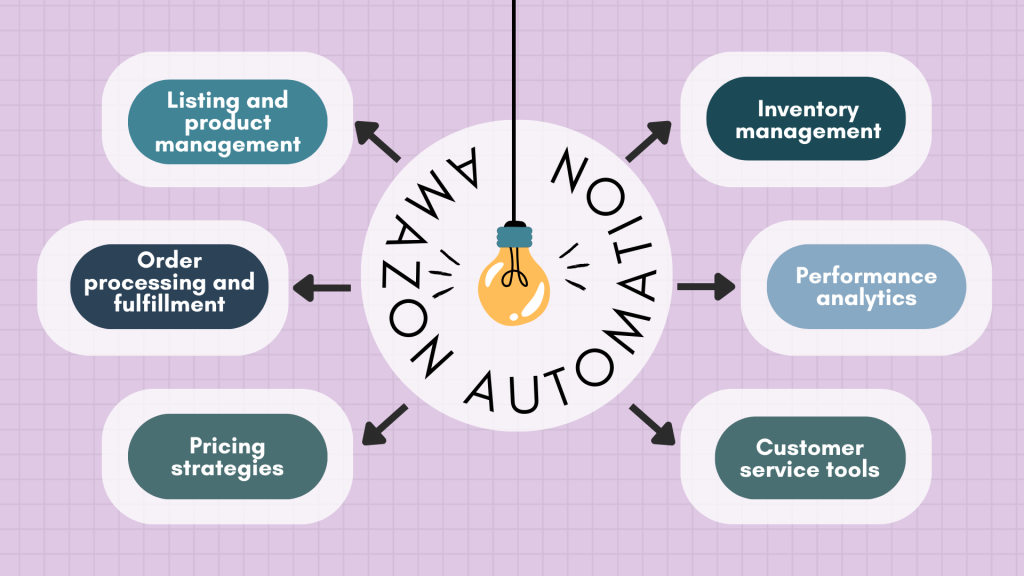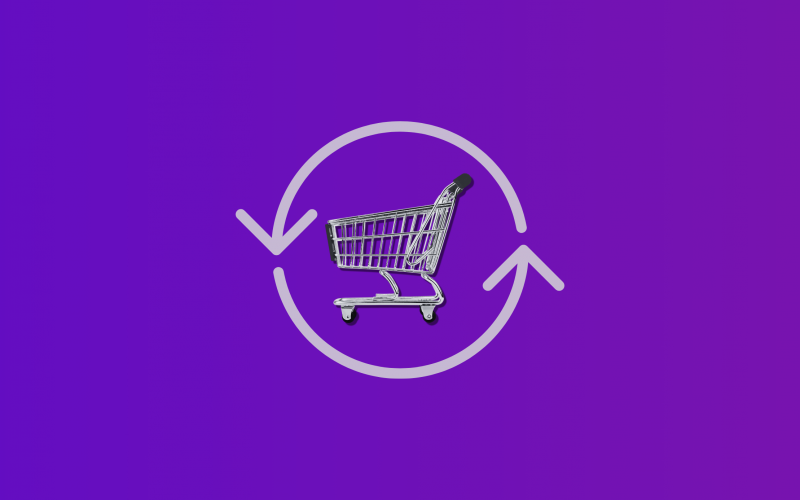The advent of Amazon automation, including the concept of an automated Amazon store, marks a transformative shift in how business engages with this expansive platform. There are multiple ways businesses can leverage Amazon automation: store self-checkout, product management, customer service, and many more.
In this article, we look at the profound influence of Amazon on ecommerce, examine the overarching trend of automation, and uncover the strategic advantages that arise from automated Amazon stores implementation.
What makes Amazon an industry elite?
Amazon’s journey from an online bookstore to an ecommerce behemoth has been incredible. The extent of Amazon’s dominance in the digital marketplace is pretty substantial. What makes it a market leader? Let’s find out.
The evolution of Amazon
Founded in 1994 by Jeff Bezos, Amazon began as an online bookstore. Its trajectory quickly expanded beyond the confines of literature. Over the years, Amazon strategically diversified its offerings, incorporating everything from electronics to groceries, streaming services, and even cloud computing. This diversification broadened its consumer base and solidified its presence as a comprehensive and indispensable platform for businesses and consumers.
Expansive user base
Amazon handles a vast and ever-growing user base. Boasting over 300 million active customers globally, Amazon has transcended geographical boundaries to become a household name in countless regions. The sheer diversity of its user base, spanning different demographics and preferences, underscores Amazon’s universal appeal. This massive reach offers businesses an unparalleled opportunity to connect with a broad spectrum of consumers, from tech enthusiasts in Silicon Valley to fashion-forward shoppers in Tokyo.
Net sales as a financial powerhouse
Let’s turn to some of Amazon’s statistics.
In 2022, Amazon’s net sales surpassed an extraordinary $386 billion, catapulting the platform into the realm of financial powerhouses. This colossal figure reflects the volume of transactions on the platform, which cements Amazon’s status as a primary revenue driver for countless businesses operating within its ecosystem.
Global reach and marketplace dynamics
Amazon’s influence extends far beyond national borders. With a global reach that spans numerous countries, Amazon has become an international marketplace that facilitates cross-border trade on an unprecedented scale. The platform’s marketplace dynamics, characterized by a robust infrastructure, efficient logistics, and a vast network of sellers, contribute to a seamless and dynamic ecommerce experience.
For businesses, this global reach translates into the potential for international expansion and market penetration, tapping into consumer bases in regions previously inaccessible.
Challenges within the Amazon ecosystem
However, while offering an expansive platform for businesses to thrive, navigating Amazon’s ecosystem has inherent challenges. Intense competition among sellers, the ever-evolving algorithms that dictate product visibility, and the stringent guidelines for product listings are among the hurdles businesses must overcome. Additionally, the dominance of Amazon’s private-label brands introduces a competitive landscape that demands strategic differentiation.
Opportunities for strategic growth
Within the challenges lie unique opportunities for businesses to grow and expand. Leveraging Amazon’s vast user base provides an immediate avenue for exposure and customer acquisition. The Fulfillment by Amazon (FBA) program streamlines logistics, offering businesses a chance to enhance their operational efficiency. Amazon Advertising enables targeted marketing, and initiatives like Amazon Prime present opportunities for driving customer loyalty.
Innovation and adaptability
Businesses might want to embrace innovation and adaptability to thrive in the Amazon ecosystem. Staying informed about changing marketplace dynamics, optimizing product listings, and harnessing the power of data analytics are crucial elements of success. Additionally, fostering a brand identity that resonates with consumers and exploring emerging trends within the ecommerce space positions businesses for sustained growth within the Amazon ecosystem.
As we delve deeper into the digital age, businesses that grasp the intricacies of Amazon’s dominance might be poised to survive and thrive in ecommerce.
Automating businesses: automation use through various industries
In the relentless pursuit of operational excellence and sustained growth, businesses across diverse industries are ushering in the era of automation.
Automation has transcended its traditional confines, evolving from mechanized production lines to a comprehensive technological paradigm that permeates nearly every sector. From manufacturing and healthcare to finance and customer service (remember those bots that reply the most common questions), industries are embracing automation to enhance efficiency, reduce costs, and unlock new levels of innovation. The underlying principle is to leverage technology to perform routine, repetitive tasks, freeing human resources for strategic decision-making and tasks that require creativity and critical thinking.
Advancements in artificial intelligence, machine learning, and robotic technologies are driving the evolution of automation. Cognitive automation, which involves the use of AI algorithms to replicate human thought processes, is reshaping how businesses approach complex problem-solving. The integration of smart technologies is not just a trend. It’s a fundamental shift in the way businesses operate, with automation being a cornerstone of sustainable growth.
Below are a couple of examples of how automation applies through various industries.
Manufacturing industry – robotics and automatic assembly lines
In automotive manufacturing, automation comes in the form of robotics and automated assembly lines. Manufacturing enterprises use robotic arms for welding, painting, and assembly tasks. These machines operate with precision and speed, increasing production efficiency and ensuring consistency in the manufacturing process.
Healthcare industry – robotic surgery and data processing
Surgical robotics has changed the healthcare industry, particularly in minimally invasive procedures. Examples include the da Vinci Surgical System, where surgeons control robotic arms from a console. These robots can precisely perform intricate tasks such as suturing and tissue manipulation, showing better results than traditional surgical methods. Automation in surgery leads to reduced invasiveness, shorter recovery times, and improved patient outcomes.
Automated data processing in the healthcare industry enables seamless data integration from various sources, including medical devices and sensors, fostering real-time insights into patient health. Sophisticated analytics tools and predictive models further enhance the interpretation of healthcare data, providing clinicians with actionable insights and facilitating informed decision-making. Automated alerts, risk stratification, and compliance reporting help healthcare professionals optimize patient care, adhere to regulatory standards, and drive continuous quality improvement initiatives.
Retail industry – self-checkout systems
Automated checkout systems (like self-service kiosks) have transformed the traditional checkout process in retail. Customers can independently scan and pay for their items without a cashier. Automation software in retail enhances the customer experience by reducing waiting times. It also enables businesses to optimize staffing resources and improve overall operational efficiency.
Finance industry – robotic process automation (RPA)
The finance industry leverages Robotic Process Automation (RPA) for transaction processing, data entry, and more. It employs bots to handle repetitive and rule-based processes, including updating customer information and processing routine transactions. RPA enhances accuracy, reduces processing times, and allows human employees to focus on more complex tasks that require critical thinking.
The anatomy of Amazon automation: exploring automated Amazon experience
Above, we spoke about how Amazon creates automated experiences for businesses and customers. Now, we suggest looking at it in more detail and exploring ways Amazon applies automation, supporting various business types, from classic retail to wholesale businesses.
Amazon automation: storefront and back-end management with Amazon Go
Amazon has pioneered the concept of entirely self-checkout stores through its Amazon Go locations.
The front-end automation in these stores involves advanced computer vision, sensor fusion, and machine learning technologies. Customers enter the store by scanning an Amazon Go app. As they shop, the system automatically detects when products are taken from or returned to shelves. The checkout process is entirely frictionless – customers exit the store, and the system charges their Amazon accounts for the items they take. This front-end Amazon automation enhances the customer experience by eliminating the need for traditional checkouts.
On the back end, the automated inventory management system works, syncing real-time changes in stock levels. Each item has unique identifiers, and the system updates inventory counts instantaneously as customers make purchases. It ensures accurate stock levels, reduces the risk of overstock or stockouts, and optimizes the supply chain.
Overall, the combination of front-end and back-end automation in Amazon Go stores streamlines the shopping experience and enhances operational efficiency.
Amazon store automation: Amazon automation for the Marketplace sellers (from automated product management to customer service)
In the Amazon Marketplace, one of the leading ecommerce platforms in the US, automation plays a significant part in both front-end and back-end operations management.

Front-end Amazon automation for sellers includes:
- Listing and product management:
Sellers can use automated tools to efficiently list products on the marketplace, manage inventory, and update product details. Automated listing tools help optimize product listings for visibility and sales. - Order processing and fulfillment
Automated order processing systems handle order confirmation, shipping, and tracking. Fulfillment by Amazon (FBA) is a program where sellers can leverage Amazon’s automated fulfillment centers for storage, packing, and shipping, streamlining the entire order fulfillment process. - Pricing strategies
Dynamic pricing tools use algorithms to adjust prices based on market conditions, competitor pricing, and other factors. This automated approach helps sellers remain competitive and maximize revenue.
Back-end operations aren’t left at the curb either. The back-end Amazon automation is impressive and simplifies store management a lot.
- Inventory management
Sellers benefit from automated inventory management systems that provide real-time updates on stock levels. This helps in preventing overselling or stockouts, ensuring accurate product availability on the marketplace. - Performance analytics
Sellers can access automated analytics tools that generate reports on key performance metrics, sales trends, and customer behavior. This data-driven insight enables sellers to make informed decisions and refine their strategies. - Customer service
Automated customer service tools, including chatbots and automated responses, can handle routine customer inquiries, improving response times and efficiency. Sellers can also automate order-related communications, such as shipping notifications.
As you can see, Amazon automation extends from entirely self-checkout stores, enhancing the customer experience and streamlining inventory management, to the Amazon Marketplace, where front-end and back-end automation tools empower sellers to manage listings, orders, and customer interactions efficiently. Amazon’s automation is a central element in it’s commitment to providing a seamless shopping experience for customers and optimizing operations for sellers in its expansive marketplace.
How to automate your ecommerce business: Amazon automation best practices
The strategic implementation of Amazon automation is not just a luxury but a necessity for businesses looking to stay competitive and efficiently navigate the complexities of online retail. A this point, leveraging Amazon automation tools effectively can be a game-changer. Here are some best practices for Amazon automation, focusing on optimizing your operations and harnessing the integration capabilities that Amazon offers.
- Streamlining listings and inventory management
Leverage Amazon automation tools not just to list products but to optimize them for visibility and sales. Ensure your inventory is synchronized in real-time, preventing issues like overselling or stockouts. Explore features such as automated repricing to dynamically adjust product prices based on market conditions, ensuring competitiveness. - Seamless order processing with Fulfillment by Amazon (FBA)
Consider utilizing FBA to leverage Amazon’s automated fulfillment centers for storage, packing, and shipping. This not only streamlines the order fulfillment process but also enhances customer satisfaction with reliable and swift deliveries. - Dynamic pricing strategies
Automate your pricing strategies using algorithms that take into account market conditions, competitor pricing, and other relevant factors. This ensures that your product prices remain optimized for maximum revenue while adapting to the nuances of the market. - Utilizing performance analytics
Make the most of automated analytics tools provided by Amazon to gain deep insights into your performance metrics, sales trends, and customer behavior. These analytics can inform your decision-making processes, allowing you to refine your strategies and optimize your approach based on data-driven insights. - Customer service automation
Enhance your customer service operations by automating routine inquiries through chatbots and automated responses. This not only improves response times but also allows your team to focus on more complex customer issues that require personalized attention. Consider automating order-related communications, such as shipping notifications, to keep customers informed and engaged throughout the purchase journey. - Integration with accounting systems
One often overlooked but crucial aspect of Amazon automation is the integration with accounting systems. To streamline your financial processes and have a comprehensive view of your business, integrate Amazon with your accounting software. This integration allows for the seamless flow of sales and transaction data, providing a centralized ecosystem for managing your finances. It eliminates manual data entry, reduces errors, and facilitates efficient financial reporting. - Explore third-party automation tools
While Amazon automation tools are quite robust, you might want to consider exploring third-party solutions that complement and enhance your Amazon automation efforts. These tools can offer additional functionalities and customization options to cater to the specific needs of your ecommerce business.
This way, automating your ecommerce business on Amazon is not just about using the available tools but doing so strategically and efficiently. By streamlining listings, leveraging FBA, employing dynamic pricing, analyzing performance, improving customer service, and integrating with accounting systems, you can create a well-oiled machine that not only saves time and resources but also enhances the overall customer experience.
A quick look at starting and setting up Amazone stores
Starting and setting up your automated Amazon store involves several key steps. And we’ll recall them real quick.
- Begin by researching and choosing a niche for your Amazon business. Create an Amazon Seller account on the web through Amazon Seller Central, opting for either an Individual or Professional account based on your anticipated sales volume.
- Next, focus on product sourcing for your Amazon store. Determine whether you’ll be dropshipping, utilizing a fulfillment center, or managing your own inventory. It’s crucial to find reliable suppliers for your Amazon products to ensure the smooth operation of your Amazon store.
- Proceed to set up your Amazon store on the web, customizing its appearance with your store name, logo, and banner. Optimize your product listings with compelling titles, detailed descriptions, and high-quality images, keeping a sharp focus on enhancing your Amazon automation.
- Choose a fulfillment method that aligns with your business model, whether it’s Amazon FBA, Fulfilled by Merchant (FBM), or dropshipping. To streamline your operations, consider implementing automated inventory management tools or software to monitor stock levels efficiently.
- In terms of marketing, leverage the power of Amazon PPC advertising to promote your products on the web. Additionally, explore other marketing channels and use social media to drive traffic to your Amazon store and boost sales for your Amazon business.
- Implement automated pricing strategies by utilizing repricing tools to ensure competitiveness and adapt to market trends. Focus on delivering exceptional customer service through automated responses and timely support, thereby enhancing the overall customer experience of your Amazon store.
- Keep a keen eye on analytics by regularly monitoring your Amazon business’s performance metrics, sales data, and customer feedback. Use these insights to adapt and optimize your strategies for sustained growth in your automated Amazon store.
Ultimately, you might want to ensure compliance with Amazon’s policies and stay informed about any changes to their algorithms or ecommerce trends. This commitment to staying informed and adapting to the evolving landscape will contribute to the success and scalability of your Amazon business.
Final word
In navigating Amazon automated store, the strategic deployment of tools becomes paramount. It extends beyond a mere adoption of automation, demanding a calculated and precise utilization of its capabilities. The orchestration of streamlined front-end operations, encompassing listings, inventory management, and the strategic leveraging of Fulfillment by Amazon (FBA), sets the stage for an efficient order processing experience. Dynamic pricing strategies, powered by automation, guarantee competitiveness in the ever-shifting market, while analytics offer real-time insights, equipping sellers to refine strategies based on concrete information.
However, the narrative transcends the customer-facing realm. Seamlessly integrating Amazon with accounting systems emerges as a linchpin, harmonizing finances and streamlining transactions within the expansive Amazon store. This integration not only reduces manual efforts and errors but furnishes a comprehensive financial snapshot within a centralized ecosystem. The careful orchestration of efficient customer service through automation adds the final flourish, enhancing responsiveness while sustaining a focus on intricate customer concerns. As we chart the course into the future of the Amazon business landscape, those who adeptly wield Amazon automation, utilize tools like Jungle Scout and Fiverr for design and sales optimization, and strategically navigate the Amazon FBA ecosystem are positioned as true innovators, propelling their business to new heights of success.







.png)
